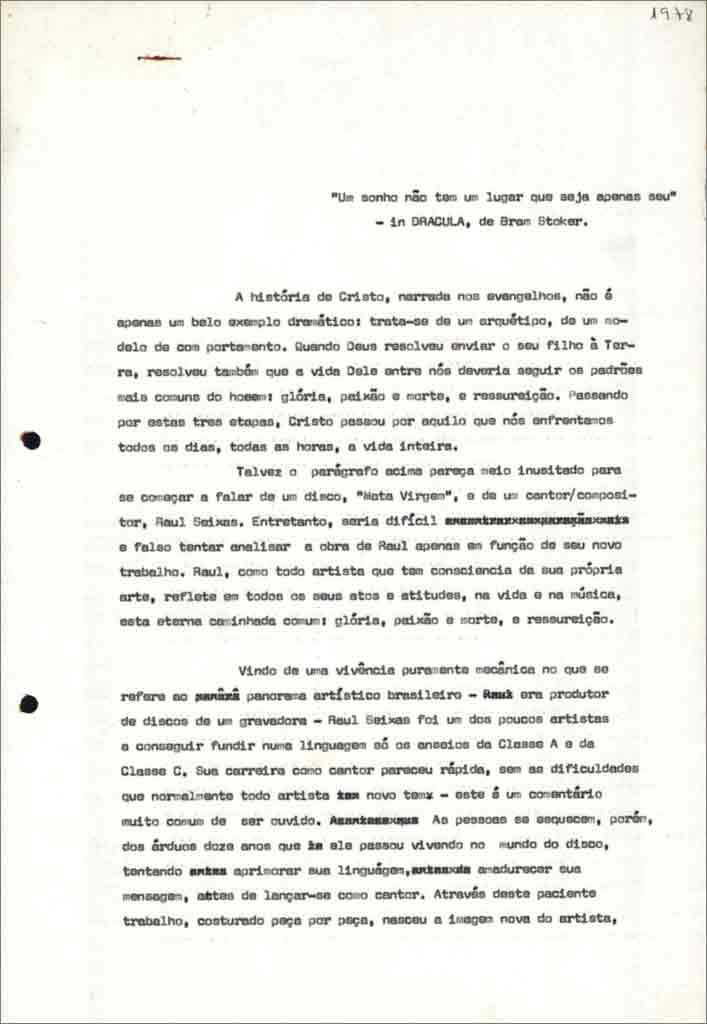

Notes about Raul Seixas’ album “Mata Virgem” (Virgin Forest)
Excerpt:
A história de Cristo, narrada nos evangelhos, não é apenas um belo exemplo dramático: trata-se de um arquétipo, de um modelo de comportamento. Quando Deus resolveu enviar o seu filho à Terra, resolveu também que a vida Dele entre nós deveria seguir os padrões mais comuns do homem: glória, paixão e morte, e ressureição. Passando por estas três etapas, Cristo passou por aquilo que nós enfrentamos todos os dias, todos as horas, a vida inteira.
Talvez o parágrafo acima pareça meio inusitado para se começar a falar de um disco, “Mata Virgem”, e de um cantor/compositor, Raul Seixas. Entretanto, seria difícil e falso tentar analisar a obra de Raul apenas em função de seu novo trabalho. Raul, como todo artista que tem consciência de sua própria arte, reflete em todos os seus atos e atitudes, na vida e na musica, esta eterna caminhada comum: gloria, paixão e morte, e ressureição.
Vindo de uma vivência puramente mecânica no que se refere ao panorama artístico brasileiro – era produtor de discos de um gravadora – Raul Seixas foi um dos poucos artistas a conseguir fundir numa linguagem só os anseios da Classe A e da Classe C. Sua carreira como cantor pareceu rápida, sem as dificuldades que normalmente todo artista novo tem – este é um comentário muito comum de ser ouvido. As pessoas se esquecem, porém, dos árduos doze anos que ele passou vivendo no mundo de disco, tentando aprimorar sua linguagem, amadurecer sua mensagem, antes de lançar-se como cantor. Através deste paciente trabalho, costurado peça por peça, nasceu a imagem novo o artista, o estilo então sem precedentes no Brasil, a “loucura” que conseguia colocar com extrema lucidez os nossos problemas diários. E Raul desempenhou seu papel de ídolo melhor que ninguém. Muitas vezes, num intervalo de show, ele comentava: “como está indo o sujeito no palco?”, referindo-se a si mesmo, procurando analisar-se com profundidade e afastamento, para que pudesse dar o melhor de si. Era preciso ter alguém cantando, e Raul fazia isto; era preciso ter alguém vivendo o dia-a-dia para que a música não se tornasse alienada, e Raul também fazia isto. Foi a época em que se fez “Ouro de Tolo”, “Gita”, Medo da Chuva”, Krig-ha Bandolo”.
Excerpt translation (unofficial):
The Story of Christ, narrated in the Gospels, is not just a beautiful dramatic example: it is an archetype, a model of behavior. When God decided to send his son to Earth, he also resolved that his life among us should follow the most common patterns of Man: glory, passion and death, and resurrection. Going through these three steps, Christ went through what we face every day, every hour, our whole life.
Perhaps the above paragraph seems a little unusual to start talking about a record, “Mata Virgo”, and a singer/songwriter, Raul Seixas. However, it would be difficult and false to try to analyze Raul’s work solely based on his new record. Raul, like every artist who is aware of his own art, reflects in all his acts and attitudes, in life and in music, this eternal common walk: glory, passion and death, and resurrection.
Coming from a purely mechanical experience with regard to the Brazilian artistic scene – he was a producer at a record label – Raul Seixas was one of the few artists to be able to merge in a language only the yearnings of class A and class C. His career as a singer went fast, without the hardships that every new artist usually has – this is a very common comment to be heard. People forget, however, the arduous twelve years he spent living in the record world, trying to hone his language, mature his message, before launching himself as a singer. Through this patient work, put together piece by piece, emerged the new image of the artist, the style then unprecedented in Brazil, the “madness” that could describe with extreme lucidity our daily problems. And Raul played his idol role better than anyone. Often, during a break in a show, he commented: “How is the guy doing on stage?”, referring to himself, looking to analyze himself in-depth and detached, so that he could give the best of himself. It was necessary to have someone sing, and Raul did this; It was necessary to have someone living the day-to-day so that the music would not become alienated, and Raul also did this. It was the time when it was made “Ouro de Tolo” (Fool’s Gold), “Gita”, “Medo da Chuva” (Fear of Rain), “Krig-ha Bandolo”.

 Back To Top
Back To Top